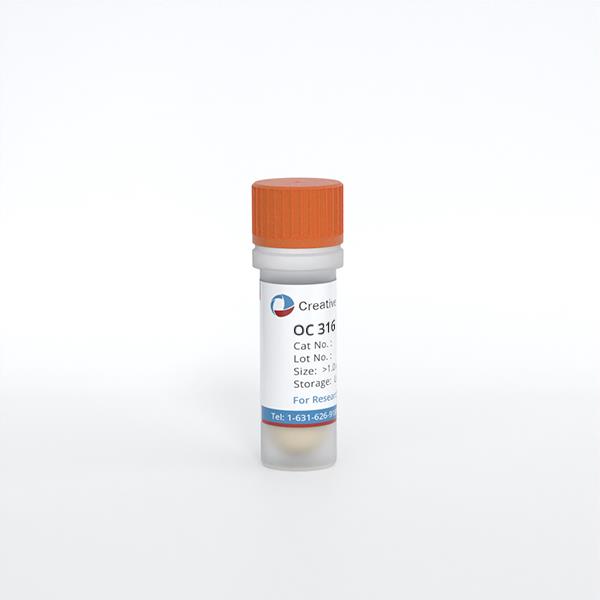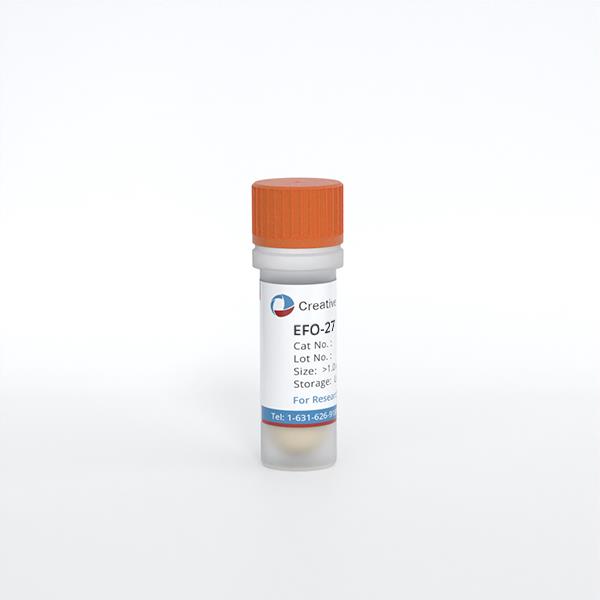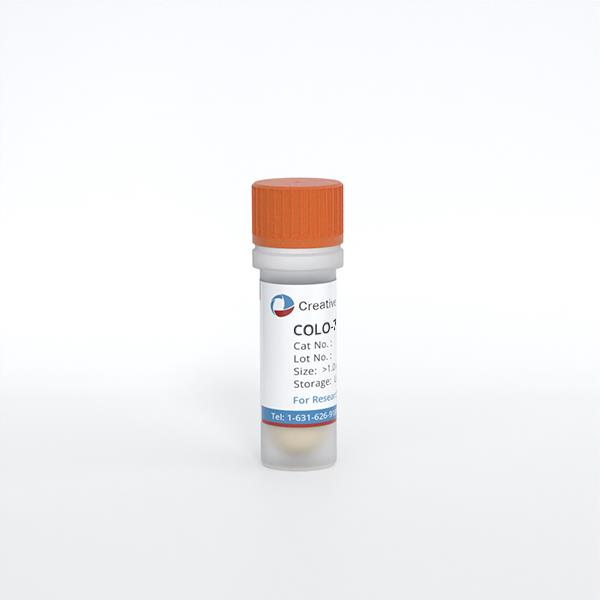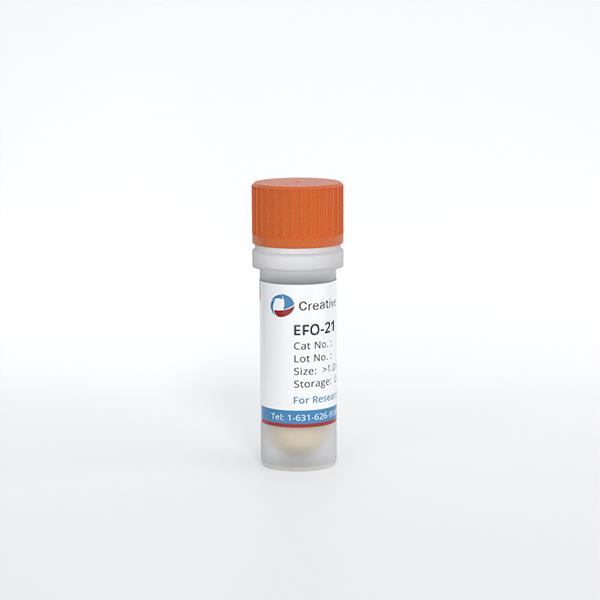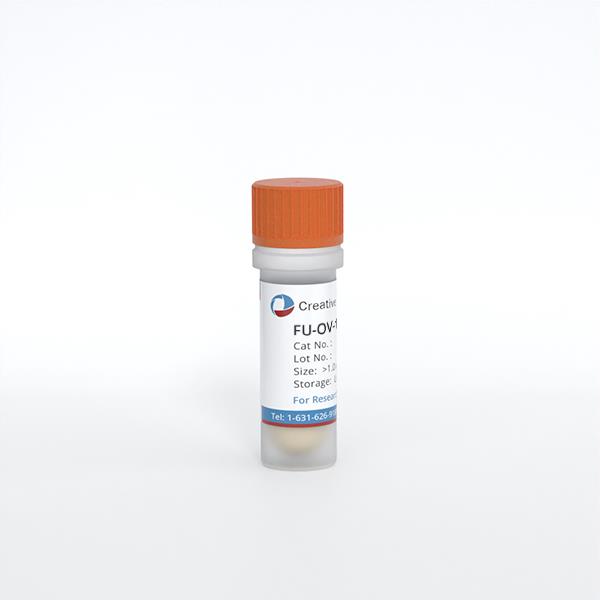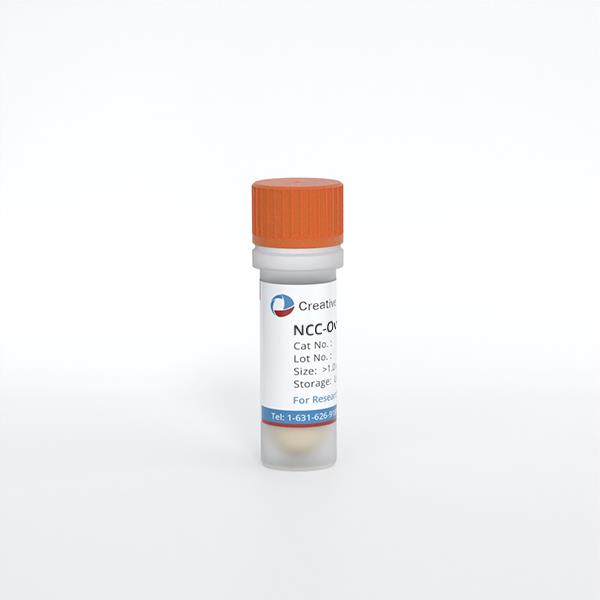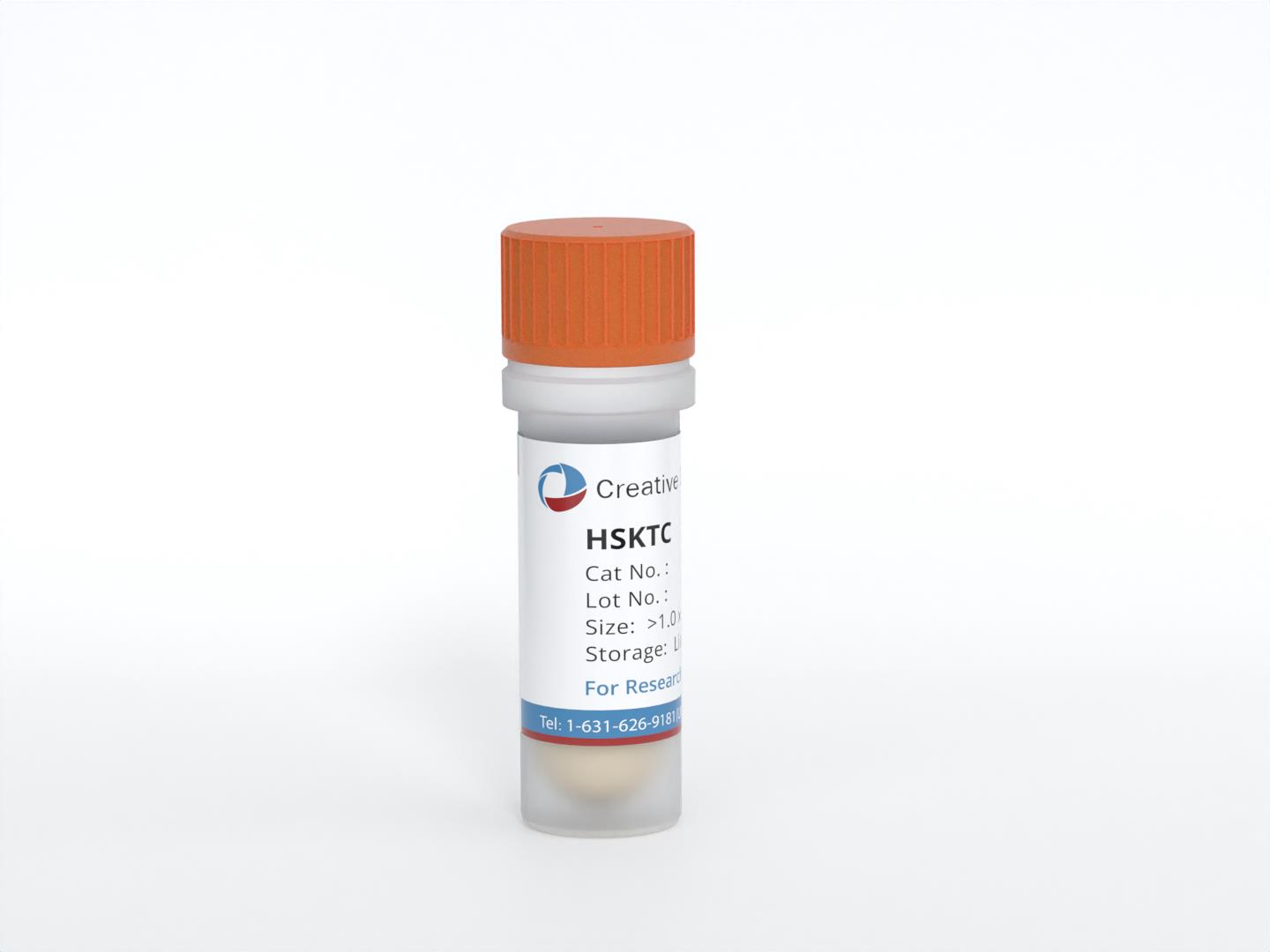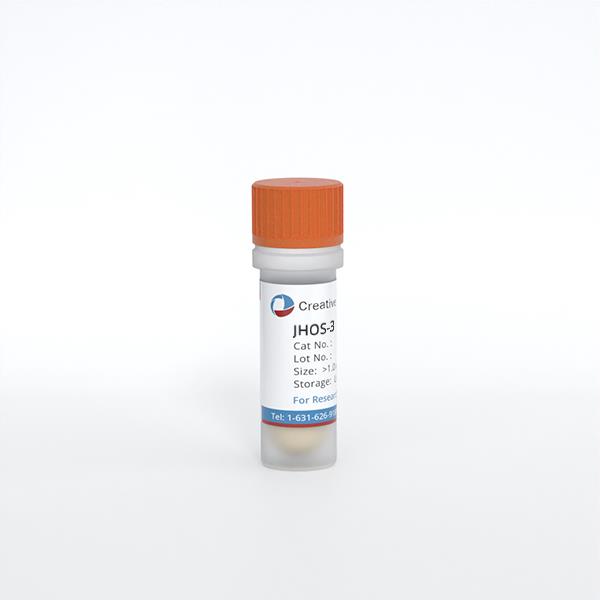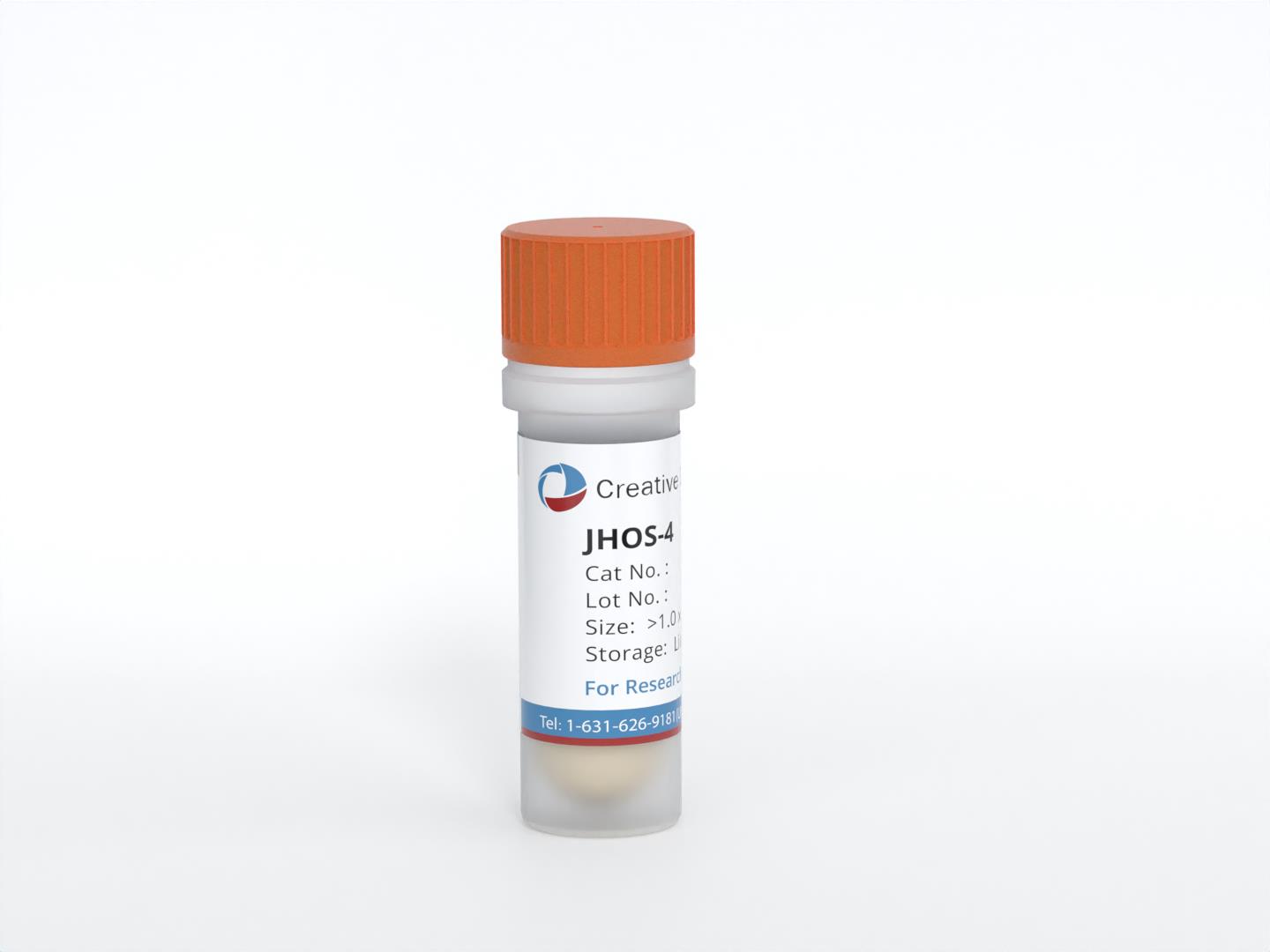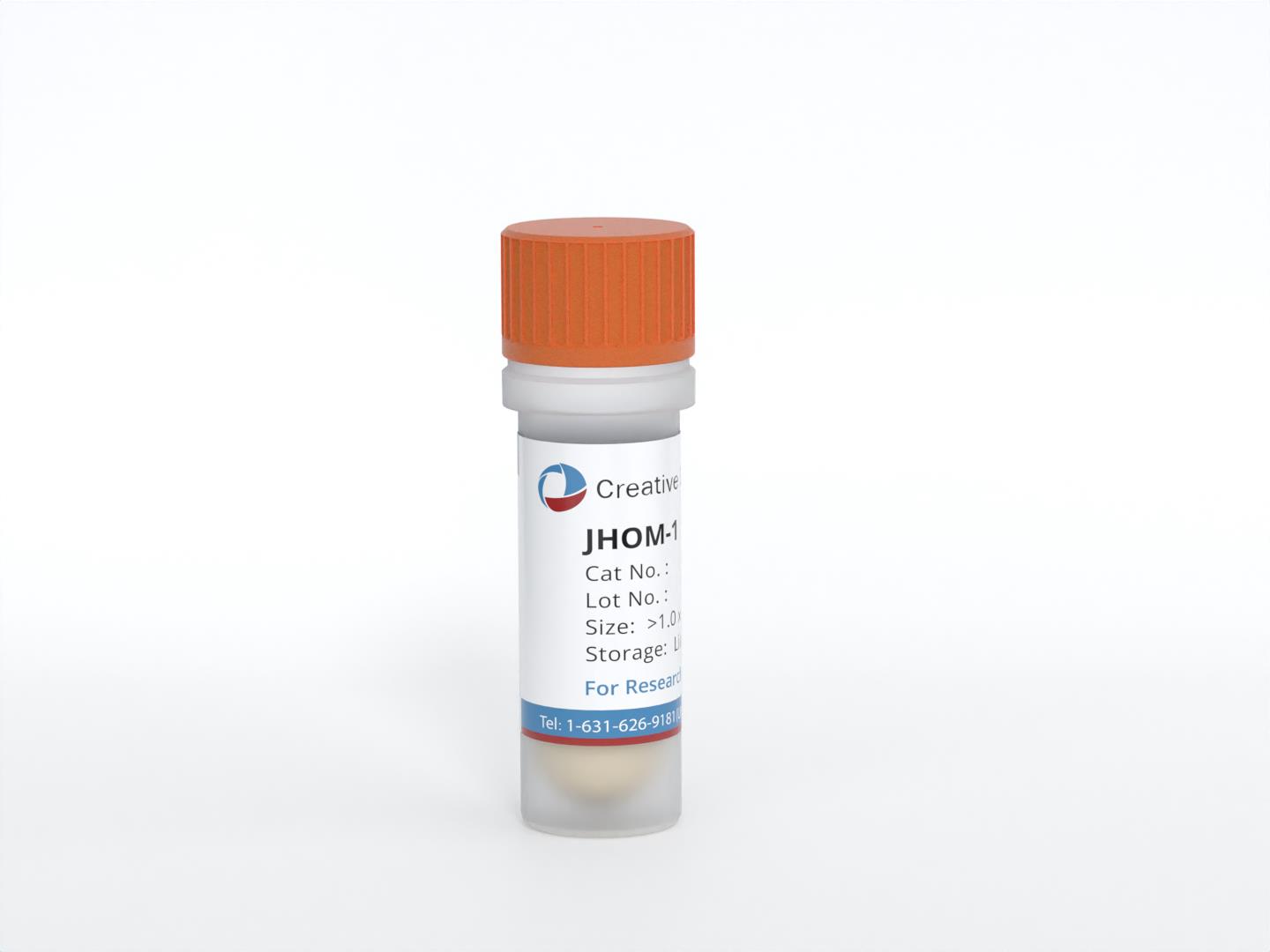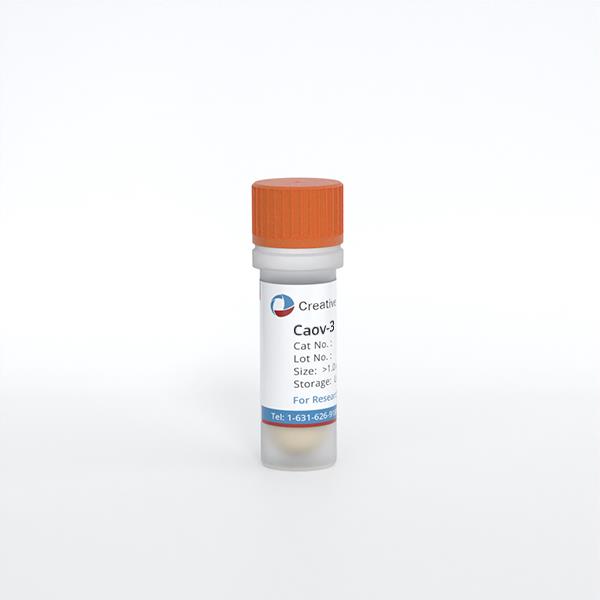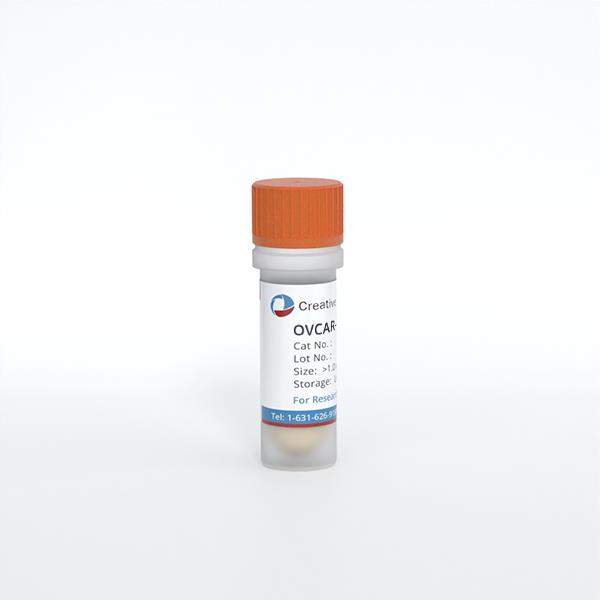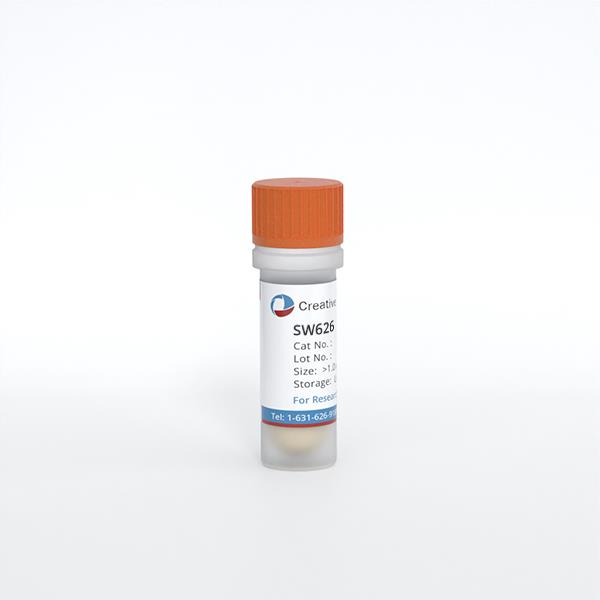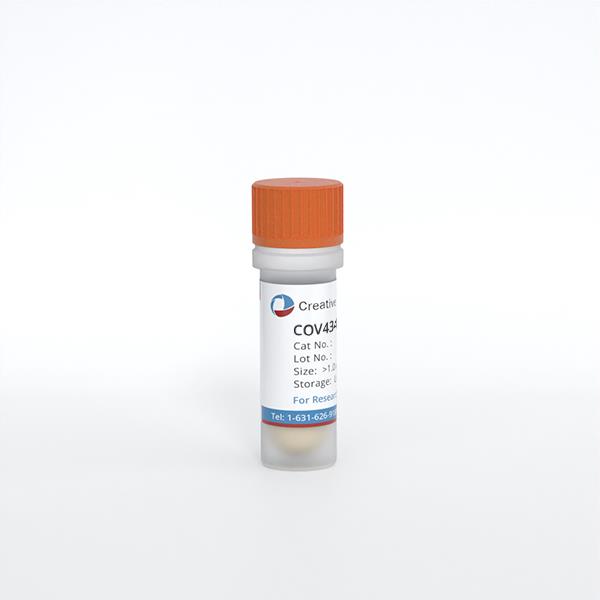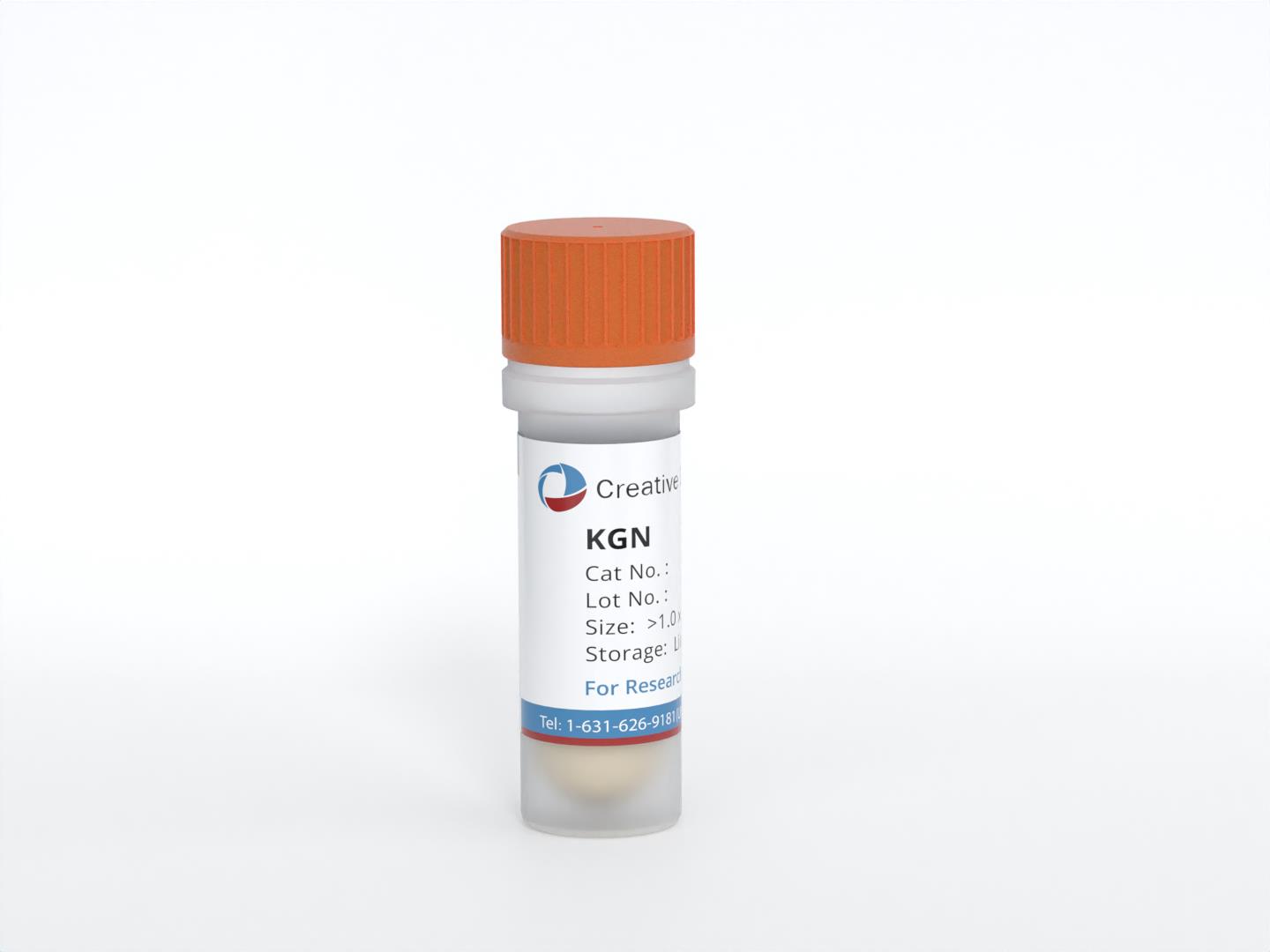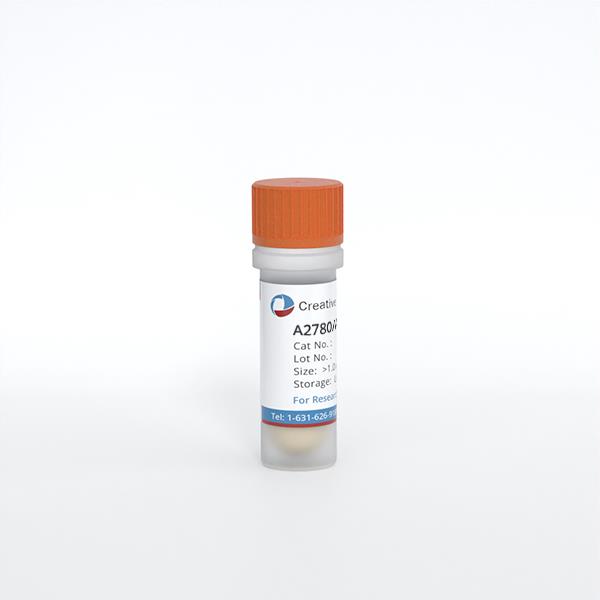Ovarian Tumor Cells
- Background
- Applications
- Scientific Data
Ovarian tumor cells, primarily associated with ovarian cancer, present a complex challenge in oncology due to their diverse histological types and biological behaviors. Ovarian cancer remains one of the leading causes of cancer-related deaths among women globally. The majority of ovarian tumors are classified as epithelial tumors, which arise from the ovarian surface epithelium.
Molecular Biology of Ovarian Tumor Cells
- Genetic alterations. The molecular characterization of ovarian tumor cells has revealed numerous genetic mutations that drive tumorigenesis. The most notable are mutations in the BRCA1 and BRCA2 genes, which significantly increase the risk of developing ovarian and breast cancers. Studies indicate that about 15-20% of high-grade serous ovarian cancers (HGSC) harbor mutations in these genes.
- Tumor microenvironment. Ovarian tumor cells interact with surrounding stromal cells, immune cells, and extracellular matrix components, leading to changes that facilitate tumor growth and metastasis. For example, fibroblasts in the stromal tissue can secrete growth factors such as transforming growth factor-beta (TGF-β) which promotes epithelial-to-mesenchymal transition (EMT). This process contributes to the increased invasiveness of tumor cells.
- Molecular pathways. Key signaling pathways involved in ovarian tumor biology include the PI3K/Akt and MAPK pathways. Dysregulation of these pathways enhances cell proliferation and survival. Research has shown that in about 70% of ovarian tumors, there are alterations in the PI3K pathway, which often correlates with poor prognosis.
Model Systems for Research
Ovarian tumor cells are used to create model systems that mimic the behavior of tumors in the body. Cultured cells that grow indefinitely and are used for experiments that require a large number of cells. Tumor cells are implanted into immunodeficient mice to study tumor growth, metastasis, and response to treatments in a more physiological context. Three-dimensional cultures recapitulate the architecture of the tumor and are useful for studying tumor-stroma interactions and drug response.
Genetic and Epigenetic Studies
Mesothelioma cell lines and animal models derived from these cells are essential in the preclinical phase of drug discovery. These models allow researchers to test the efficacy and toxicity of new drugs or combinations of drugs. This process helps to prioritize the most promising candidates for further development and clinical trials.
Immunotherapy Research
Ovarian tumor cells play a role in the development of immunotherapies, which harness the immune system to fight cancer. This includes creating vaccines that stimulate an immune response against specific antigens present in ovarian tumor cells. Additionally, identifying and targeting molecules on tumor cells that interact with immune cells to inhibit the body's immune response.
Functional Role of FZD7 in Ovarian Cancer Cells
Platinum-tolerant cells and tumors were enriched in ALDH(+) cells, formed more spheroids, and expressed increased levels of stemness-related transcription factors compared to parental cells. Additionally, platinum-tolerant cells and tumors exhibited expression of the Wnt receptor Frizzled 7 (FZD7). Knockdown of FZD7 improved platinum sensitivity, decreased spheroid formation, and delayed tumor initiation.
To further examine the functions of FZD7, the receptor was knocked down (KD) by stable transduction of shRNA or was transiently overexpressed. Decreased FZD7 mRNA expression was confirmed by Q-RT-PCR in SKOV3 and OVCAR5 cells transduced with two shRNA sequences targeting the receptor (Fig. 1A-B). FZD7 KD decreased spheroid formation (Fig. 1A-B) and expression of stemness-associated TFs (Fig. 1C). In vitro serial limited dilution assay showed that receptor KD decreased stem cell frequency, as calculated by the ELDA software in FZD7 KD vs. control cells, (p = 0.034). Likewise, FZD7 KD in Pt-T SKOV3_CDDP cells decreased sphere formation. Stable FZD7 KD in primary Pt-R tumor cells caused decreased expression levels of the stemness-associated gene ALDH1A1 (Fig. 1D-E). Conversely, transient overexpression of FZD7 (Fig. 1E-F) promoted the proliferation of SKOV3 and OVCAR5 cells as spheres (Fig. 1G) and increased the expression of stemness-associated TFs. FZD7 KD decreased IC50 to cisplatin by 2-fold (SKOV3, Fig. 1H; SKOV3_CDDP, Fig. 1I); while the receptor's overexpression increased Pt resistance (Fig. 1J).
To test the effects of FZD7 on tumor growth, a subcutaneous (s.c.) xenograft model was used. FZD7 KD in OVCAR5 cells delayed tumor initiation (sh-control 9.8±4 days. vs. sh-FZD7 25.3±4.9 days, Fig. 1K, p < 0.0001) and decreased tumor size and tumor weight (0.80±0.41 g vs. 0.14±0.15 g, p = 0.04, n = 4/group). FZD7 KD in xenografts was confirmed by IHC. ALDH (+) cells (16.5±6.5% vs. 5.9±1.8%, p= 0.05; Fig. 1L, n = 3) and spheroid forming ability (Fig. 1M, p = 0.02) were decreased in cells dissociated from FZD7 KD vs. control xenografts. Further, to test the effects of FZD7 KD on tumor initiation, an in vivo serial limited dilution assay was carried out by using 2,500; 5,000; and 10,000 FZD7 KD and control cells. FZD7 KD significantly inhibited TIC (Figure 4N) and reduced stem cell frequency, as calculated by the ELDA software (Fig. 1O). Combined, these results support that FZD7 is linked to stemness and chemo-resistance.
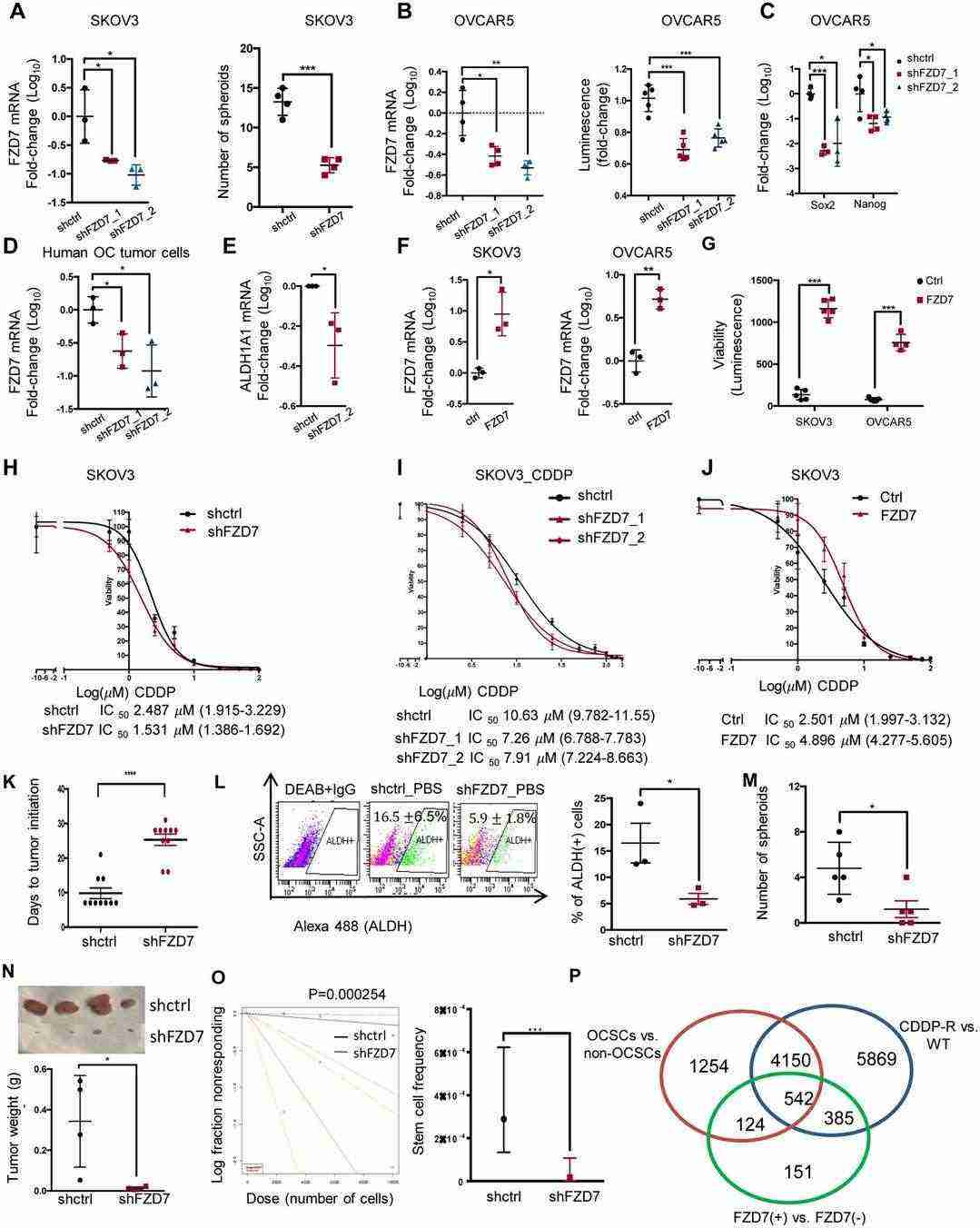 Fig. 1 FZD7 regulates stemness
characteristics. (Wang Y, et al, 2020)
Fig. 1 FZD7 regulates stemness
characteristics. (Wang Y, et al, 2020)
Knock-Down of RFC3 Alleviated the Viability and Proliferation of OVCAR-3 Cells
Ovarian carcinoma is one of the most common and lethal malignancies in the world. Replication factor C (RFC) plays an important role in DNA replication, DNA damage repair, and checkpoint control during cell cycle progression in all eukaryotes. The effect of RFC3 knocking down ovarian tumor cells was sought to explore. To this end, the viability and proliferation of RFC3 knocking down OVCAR-3 cells were examined, respectively. Briefly, RFC3 knocking-down OVCAR-3 and NC cells at different time points (Day 1, Day 2, and Day 3, respectively) were examined by MTS assays. The knock-down of RFC3 decreased cell viability compared to NC (Fig. 2A). Moreover, the cell growth was also examined by digesting cells at different time points into a single-cell suspension and counting the living cells. As shown in Fig. 2B, the knockdown of RFC3 notably decreased the number of living cells. Taken together, these results indicated that the knockdown of RFC3 was detrimental to the viability and proliferation of ovarian cancer cells.
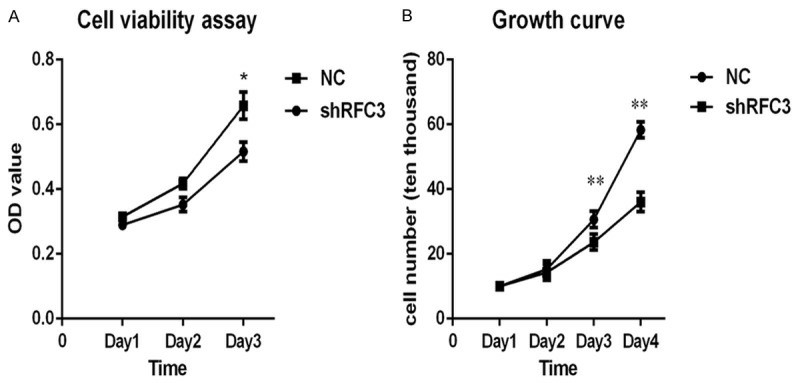 Fig. 2 Knock-down
of RFC3 alleviated cell viability and proliferation in OVCAR-3 cells. A. MTS assays showed that knock-down of
RFC3 suppressed cell viability in ovarian cancer cells. B. The effect of RFC3-interfering on ovarian cancer cell
proliferation, and cell proliferation were evaluated via cell growth curve assays. (Shen H, et al.,
2015)
Fig. 2 Knock-down
of RFC3 alleviated cell viability and proliferation in OVCAR-3 cells. A. MTS assays showed that knock-down of
RFC3 suppressed cell viability in ovarian cancer cells. B. The effect of RFC3-interfering on ovarian cancer cell
proliferation, and cell proliferation were evaluated via cell growth curve assays. (Shen H, et al.,
2015)
Filters Clear all filters
Species
- African clawed frog (1)
- American mink (1)
- Asian tiger mosquito (1)
- Atlantic salmon (1)
- Bluegill (2)
- Bluestriped grunt (1)
- Bovine (7)
- Brazilian free-tailed bat (1)
- Brown bullhead (2)
- Cabbage looper (1)
- Cabbage moth (6)
- Cat (4)
- Central mudminnow (1)
- Chicken (3)
- Chinese hamster (5)
- Chinook salmon (2)
- Chum salmon (1)
- Coho salmon (1)
- Common carp (2)
- Cotton-top tamarin (1)
- Dog (2)
- Fall armyworm (3)
- Fathead minnow (2)
- Fruit fly (1)
- Gilthead sea bream (2)
- Golden hamster (7)
- Goldfish (6)
- Gray dwarf hamster (1)
- Green monkey (2)
- Gypsy moth (1)
- Horse (1)
- Human (972)
- Japanese eel (1)
- Japanese rice fish (7)
- Koi carp (1)
- Mouse (316)
- Mouse x Gray dwarf hamster (1)
- Mouse x Rat (20)
- Northern pike (1)
- Pig (3)
- Rabbit (2)
- Rainbow trout (3)
- Rat (115)
- Rhesus macaque (1)
- Salt marsh moth (1)
- Sheep (2)
- Snakehead murrel (2)
- Sockeye salmon (1)
- Vervet monkey (2)
- Zebrafish (2)
Source
- Abdomen (1)
- Abdomen Metastasis (2)
- Adipose (2)
- Adrenal Gland (8)
- Adrenal Gland Metastasis (2)
- Aorta (4)
- Artery (1)
- Ascites (28)
- Ascites Metastasis (35)
- Bile Duct (3)
- Bladder (26)
- Bladder Metastasis (1)
- Blastocyst (1)
- Blastula (1)
- Blood (126)
- Bone (26)
- Bone Marrow (57)
- Bone Marrow Metastasis (18)
- Bone Metastasis (6)
- Brain (55)
- Brain Metastasis (8)
- Breast (30)
- Bronchus (1)
- Caudal Peduncle (1)
- Caudal Trunk (2)
- Cecum (3)
- Cerebrospinal Fluid (1)
- Cerebrospinal Fluid Metastasis (1)
- Cervix (31)
- Colon (82)
- Connective Tissue (7)
- Cornea (3)
- Cutaneous Metastasis (1)
- Dermis (2)
- Duodenum (1)
- Embryo (29)
- Endometrium (17)
- Esophagus (44)
- Eye (12)
- Eye Socket (5)
- Fetus (3)
- Fin (9)
- Foreskin (4)
- Gallbladder (1)
- Gingiva (2)
- Globe (2)
- Glomerulus (2)
- Groin (1)
- Head Kidney (2)
- Heart (4)
- Hemolymph (1)
- Hypodermis Metastasis (5)
- Ileum (1)
- Intestine (85)
- Jejunum (1)
- kidney (1)
- Kidney (27)
- Liver (34)
- Liver Metastasis (15)
- Lung (57)
- Lung Metastasis (8)
- Lymph Node (8)
- Lymph Node Metastasis (55)
- Muscle (7)
- Muscle Metastasis (2)
- Nose (2)
- Omentum Metastasis (2)
- Oral Cavity (10)
- Ovary (20)
- Ovary Metastasis (2)
- Pancreas (19)
- Pelvic Wall Metastasis (1)
- Pelvis (1)
- Perianal Space Metastasis (1)
- Pericardial Effusion (1)
- Pericardial Effusion Metastasis (2)
- Perineus (1)
- Peripheral Blood (125)
- Peripheral Nervous System (21)
- Peritoneal Effusion (2)
- Peritoneum (1)
- Peritoneum Metastasis (1)
- Pharynx (1)
- Pituitary Gland (7)
- Pleural Effusion (52)
- Pleural Effusion Metastasis (45)
- Prostate (7)
- Rectum (15)
- Renal Pelvis (1)
- Retroperitoneal Space (2)
- Salivary Gland (2)
- Skeletal Muscle (5)
- Skin (32)
- Skin Metastasis (3)
- Small Intestine (4)
- Small Intestine Metastasis (1)
- Smooth Muscle (2)
- Soft Tissue (1)
- Soft Tissue Metastasis (1)
- Spinal Cord (2)
- Stomach (4)
- Testis (15)
- Thoracic Cavity Metastasis (6)
- Thymus (5)
- Thyroid Gland (16)
- Thyroid Gland Metastasis (1)
- Tongue (5)
- Trachea (1)
- Umbilical Cord (1)
- Umbilical Cord Blood (1)
- Urachus (1)
- Ureter (1)
- Uterus (53)
- Uvea (2)
- Vagina (2)
- Vulva (1)
Disease
- Acute Biphenotypic Leukemia (1)
- Acute Erythroid Leukemia (4)
- Acute Megakaryoblastic Leukemia (4)
- Acute Monocytic Leukemia (9)
- Acute Myeloid Leukemia (25)
- Acute Promyelocytic Leukemia (2)
- Adrenal Gland Neuroblastoma (11)
- Adult B Acute Lymphoblastic leukemia (1)
- Adult B Acute Lymphoblastic Leukemia (6)
- Adult T Acute Lymphoblastic Leukemia (6)
- Adult T Lymphoblastic Lymphoma (2)
- Adult T-Cell Leukemia/Lymphoma (1)
- Alveolar Rhabdomyosarcoma (4)
- Alveolar Ridge Squamous Cell Carcinoma (1)
- Amelanotic Melanoma (3)
- Ampulla of Vater Adenocarcinoma (1)
- Ampulla of Vater Adenosquamous Carcinoma (3)
- Anaplastic Astrocytoma (3)
- Anaplastic Large Cell Lymphoma (7)
- Askin Tumor (1)
- Astrocytoma (5)
- B Acute Lymphoblastic Leukemia (2)
- B-Cell Non-Hodgkin Lymphoma (5)
- Bare Lymphocyte Syndrome Type 2 (1)
- Barrett Adenocarcinoma (2)
- Benign Prostatic Hyperplasia (1)
- Bladder Carcinoma (14)
- Bladder Squamous Cell Carcinoma (1)
- Bovine Leukemia (2)
- Breast Adenocarcinoma (4)
- Breast Carcinoma (9)
- Breast Ductal Carcinoma (2)
- Burkitt Lymphoma (17)
- Canavan Disease (1)
- Canine Histiocytic Sarcoma (1)
- Cecum Adenocarcinoma (3)
- Central Nervous System Lymphoma (2)
- Cervical Adenocarcinoma (2)
- Cervical Adenosquamous Carcinoma (2)
- Cervical Small Cell Carcinoma (1)
- Cervical Squamous Cell Carcinoma (2)
- Chicken Bursal Lymphoma (2)
- Childhood B Acute Lymphoblastic Leukemia (13)
- Childhood T Acute Lymphoblastic Leukemia (15)
- Childhood T Lymphoblastic Lymphoma (1)
- Cholangiocarcinoma (2)
- Chronic Eosinophilic Leukemia (1)
- Chronic Lymphocytic Leukemia (2)
- Chronic Myeloid Leukemia (21)
- Clear Cell Renal Cell Carcinoma (2)
- Colon adenocarcinoma (1)
- Colon Adenocarcinoma (44)
- Colon Carcinoma (32)
- Colorectal Adenocarcinoma (1)
- Colorectal Carcinoma (1)
- Congenital Pure Red Cell Aplasia (1)
- Cutaneous Melanoma (10)
- Dedifferentiated Chondrosarcoma (1)
- Desmoplastic Melanoma (1)
- Diffuse Large B-Cell Lymphoma (29)
- Down Syndrome (2)
- EBV-Related Burkitt Lymphoma (12)
- Embryonal Carcinoma (3)
- Embryonal Rhabdomyosarcoma (3)
- Endometrial Adenocarcinoma (13)
- Endometrial Adenosquamous Carcinoma (2)
- Endometrial Carcinoma (2)
- Endometrioid Stromal Sarcoma (1)
- Epithelioid Hemangioendothelioma (1)
- Epithelioid Sarcoma (3)
- Esophageal Adenocarcinoma (6)
- Esophageal Squamous Cell Carcinoma (41)
- Essential Thrombocythemia (1)
- Ewing Sarcoma (2)
- Extraskeletal Myxoid Chondrosarcoma (1)
- Fanconi Anemia (1)
- Fibrosarcoma (1)
- Follicular Lymphoma (2)
- Gallbladder Carcinoma (2)
- Gallbladder Undifferentiated Carcinoma (2)
- Gastric Adenocarcinoma (4)
- Gastric Adenosquamous Carcinoma (1)
- Gastric Carcinoma (5)
- Gastric Choriocarcinoma (1)
- Gastric Fundus Carcinoma (1)
- Gastric Signet Ring Cell Adenocarcinoma (1)
- Gastric Small Cell Carcinoma (2)
- Gastric Tubular Adenocarcinoma (5)
- Gastroesophageal Junction Adenocarcinoma (1)
- Gestational Choriocarcinoma (1)
- Gingival Squamous Cell Carcinoma (2)
- Glioblastoma (18)
- Gliosarcoma (1)
- Goldfish Erythrophoroma (4)
- Hairy Cell Leukemia (1)
- Hamster Kidney Tumor (1)
- Hamster Pancreatic Ductal Adenocarcinoma (1)
- Hamster Uterine Leiomyosarcoma (1)
- Hepatoblastoma (1)
- Hepatocellular Carcinoma (6)
- Hepatosplenic T-Cell Lymphoma (2)
- Hereditary Thyroid Gland Medullary Carcinoma (1)
- High Grade B-Cell Lymphoma (1)
- High Grade Ovarian Serous Adenocarcinoma (7)
- Hodgkin Lymphoma (9)
- Hypopharyngeal Squamous Cell Carcinoma (1)
- Infectious Mononucleosis (1)
- Intrahepatic Cholangiocarcinoma (6)
- Invasive Breast Carcinoma of No Special Type (11)
- Invasive Breast Lobular Carcinoma (1)
- Kidney Neoplasm (1)
- Kidney Rhabdoid Tumor (1)
- Krukenberg Tumor (1)
- Liposarcoma (1)
- Lung Adenocarcinoma (16)
- Lung Giant Cell Carcinoma (8)
- Lung Large Cell Carcinoma (9)
- Lung Mucoepidermoid Carcinoma (1)
- Lung Non-Small Cell Carcinoma (2)
- Lung Small Cell Carcinoma (25)
- Lung Squamous Cell Carcinoma (9)
- Lymphoblastic Lymphoma (1)
- Malignant Peripheral Nerve Sheath Tumor (1)
- Mantle Cell Lymphoma (5)
- Mature Gastric Teratoma (1)
- Maxillary Sinus Squamous Cell Carcinoma (1)
- Medaka Hepatoma (2)
- Medulloblastoma (3)
- Melanoma (24)
- Meningioma (2)
- Minimally Invasive Lung Adenocarcinoma (1)
- Monophasic Synovial Sarcoma (1)
- Mouse Bladder Transitional Cell Carcinoma (2)
- Mouse Chondrosarcoma (1)
- Mouse Colon Adenocarcinoma (3)
- Mouse Ependymoma (2)
- Mouse Erythroid Leukemia (13)
- Mouse Fibrosarcoma (5)
- Mouse Glioblastoma (1)
- Mouse Hemangioendothelioma (1)
- Mouse Hepatocellular Carcinoma (1)
- Mouse Insulinoma (3)
- Mouse Intestinal Tract Neuroendocrine Adenoma (1)
- Mouse Islet Cell Adenoma (1)
- Mouse Kidney Carcinoma (1)
- Mouse Leukemia (10)
- Mouse Leydig Cell Tumor (1)
- Mouse Lymphoma (8)
- Mouse Mammary Gland Malignant Neoplasm (23)
- Mouse Melanoma (9)
- Mouse Multiple Myeloma (5)
- Mouse Myeloid Leukemia (3)
- Mouse Neoplasm (1)
- Mouse Neuroblastoma (21)
- Mouse Oral Cavity Squamous Cell Carcinoma (1)
- Mouse Osteosarcoma (3)
- Mouse Pituitary Gland Neoplasm (1)
- Mouse Plasmacytoma (1)
- Mouse Precursor T Cell Lymphoblastic Lymphoma/Leukemia (2)
- Mouse Pulmonary Adenoma (1)
- Mouse Pulmonary Malignant Tumor (3)
- Mouse Pulmonary Squamous Cell Carcinoma (1)
- Mouse Rectum Carcinoma (2)
- Mouse Reticulum Cell Sarcoma (2)
- Mouse Sarcoma (1)
- Mouse Teratocarcinoma (8)
- Mouse Thymic Lymphoma (3)
- Mycosis Fungoides (1)
- Myelodysplastic Syndrome (1)
- Myxofibrosarcoma (1)
- Natural Killer Cell Lymphoblastic Leukemia/Lymphoma (2)
- Neuroblastoma (26)
- Oral Cavity Squamous Cell Carcinoma (15)
- Osteoid Osteoma (1)
- Osteosarcoma (14)
- Ovarian Carcinoma (1)
- Ovarian Clear Cell Adenocarcinoma (1)
- Ovarian Endometrioid Adenocarcinoma (4)
- Ovarian Granulosa Cell Tumor (1)
- Ovarian Mucinous Adenocarcinoma (2)
- Ovarian Serous Adenocarcinoma (2)
- Ovarian Serous Cystadenocarcinoma (1)
- Ovarian Small Cell Carcinoma (1)
- Pancreatic Adenocarcinoma (13)
- Pancreatic Carcinoma (5)
- Pancreatic Ductal Adenocarcinoma (11)
- Papillomavirus-Independent Cervical Squamous Cell Carcinoma (1)
- Papillomavirus-Related Cervical Adenocarcinoma (7)
- Papillomavirus-Related Cervical Squamous Cell Carcinoma (4)
- Papillomavirus-Related Endocervical Adenocarcinoma (15)
- Paroxysmal Nocturnal Hemoglobinuria (3)
- Plasma Cell Myeloma (15)
- Pleural Epithelioid Mesothelioma (5)
- Pleural Sarcomatoid Mesothelioma (2)
- Poorly Differentiated Thyroid Gland Carcinoma (1)
- Primary Cutaneous T-Cell Non-Hodgkin Lymphoma (1)
- Primary Effusion Lymphoma (7)
- Primitive Neuroectodermal Tumor (1)
- Prostate carcinoma (1)
- Prostate Carcinoma (9)
- Rat C-Cell Carcinoma (1)
- Rat Cholangiocarcinoma (1)
- Rat Colon Adenocarcinoma (5)
- Rat Digestive System Neoplasm (1)
- Rat Fibrosarcoma (1)
- Rat Hepatocellular Carcinoma (20)
- Rat Histiocytic Sarcoma (1)
- Rat Insulinoma (2)
- Rat Leukemia (1)
- Rat Leydig Cell Adenoma (1)
- Rat Lung Carcinoma (1)
- Rat Malignant Glioma (4)
- Rat Malignant Meningioma (1)
- Rat Malignant Oligodendroglioma (2)
- Rat Malignant Thymoma (3)
- Rat Mammary Gland Adenocarcinoma (10)
- Rat Neuroblastoma (3)
- Rat Osteosarcoma (2)
- Rat Pituitary Gland Neoplasm (6)
- Rat Prostate Adenocarcinoma (3)
- Rat Rhabdomyosarcoma (1)
- Rat Sarcoma (2)
- Rat Squamous Cell Carcinoma (1)
- Rat Urinary Bladder Transitional Cell Carcinoma (2)
- Rat Urinary System Neoplasm (6)
- Rectal Adenocarcinoma (13)
- Rectosigmoid Adenocarcinoma (1)
- Recurrent Bladder Carcinoma (1)
- Renal Cell Carcinoma (7)
- Renal Pelvis Urothelial Carcinoma (1)
- Retinoblastoma (11)
- Sacral Chordoma (1)
- Sacrococcygeal Teratoma (1)
- Salivary Gland Squamous Cell Carcinoma (1)
- Sezary Syndrome (1)
- Shwachman-Diamond Syndrome (1)
- Skin Squamous Cell Carcinoma (2)
- Splenic Marginal Zone Lymphoma (1)
- Testicular Embryonal Carcinoma (8)
- Testicular Teratoma (2)
- Testicular Yolk Sac Tumor (1)
- Thyroid Gland Anaplastic Carcinoma (10)
- Thyroid Gland Follicular Carcinoma (4)
- Thyroid Gland Papillary Carcinoma (3)
- Thyroid Gland Sarcoma (1)
- Thyroid Gland Squamous Cell Carcinoma (2)
- Tongue Adenosquamous Carcinoma (1)
- Tongue Squamous Cell Carcinoma (6)
- Type I Endometrial Adenocarcinoma (1)
- Ureter Urothelial Carcinoma (1)
- Uterine Carcinosarcoma (2)
- Uterine Corpus Leiomyosarcoma (1)
- Uterine Corpus Sarcoma (2)
- Uveal Melanoma (2)
- Vaginal Melanoma (2)
- Vulvar Melanoma (1)
- Vulvar Squamous Cell Carcinoma (1)
Description: Species: human female 60 years old; Tissue: ovary; Tumor: adenocarcinoma, low differentiated; G3 ...
Description: Established from the solid omental metastasis of a mucinous papillary adenocarcinoma of the ovary ...
Description: Established from the ascites fluid stemming from the colon metastasis of a 46-year-old white woman ...
Description: Established from the ascitic fluid of a 56-year-old Caucasian woman with dedifferentiated serous ...
Description: Established post-hysterectomy from the tumor tissue of a 65-year-old Japanese woman with malignant ...
Description: Human cell line derived from ovarian cancer.
Description: Japanese ovarian serous adenocarcinoma. Said CA125 producing. Cell growth is slow.
Description: Human ovary serous cyst adenocarcinoma cell line. Cell growth is slow.
Description: Human ovary mucinous adenocarcinoma cell line.
Description: established from the ovary tissue of a 64-year-old woman with high grade ovarian serous ...
Description: established from ovary of a 47-year-old female with ovarian endometrioid adenocarcinoma
Description: The cells are distributed for research purposes only. The culture condition is 37℃,95% air, carbon ...
Description: Established in 1982 by T.C. Hamilton, et al. from the malignant ascites of a patient with ...
Description: The SW 626 cell line was initiated by A. Leibovitz in January 1974 at the Scott and White Clinic, ...
Description: Human ovarian granulosa tumour cell line established from a solid primary tumour.
Description: Granulosa cell tumor. Possible to produce progesterone after HCG addition. Cell growth is slow.
Description: The adriamycin-resistant cell line A2780ADR has been developed by exposure of the parent A2780 cell ...
